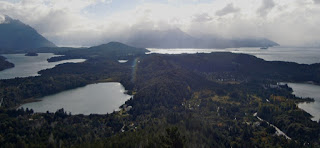For the last week and a half I have been staying in a friends apartment. There has been an emptiness since the rest of the members of my program, all my new friends that had been such a huge part of my life all went home. All week I've been reading Facebook status' and tweets of friends and acquaintances as they rejoice in their homecoming, seeing family, friends and summer. And here I am.
Part of me thought that the reason I wanted to stay was because of the people I had met. If I could just freeze time it would be ideal, that my love for the city existed within the experiences and the friends I had made which may be partly true. But since everyone left, I have found myself entering a comfortable routine with the city. Walking the streets, the parks, the ferias, not as a tourist, on a mission to see anything in particular, but as a sort of resident, appreciating living somewhere. I haven't gone to any museums, landmarks or famous cafes as I expected, I haven't tried to squeeze in the 'last few things' on my list, partly because I know I could never do it all, and partly because I know I will be back. I've been content. Sitting on the balcony, reading Marquez and Borges, making crepes, taking walks. The chilly winter weather has recently given way to a more humid, week of fog, giving the city a look of mystery and complacency.
As I walk these streets, or look out the window at the buildings with straight balconies, grimy walls, the mixture of architecture, ancient, modern and dated, cohabiting the blocks. The things I once found strange are endearing, common and necessary. Looking at Buenos Aries this way it's easy to forget the government, the economic instability, the dark and revolutionary history I have been overly exposed to in university for the past semester.
A big city that was once strange and exotic, is now comfortable, I'm used to the women in weird shoes with their waist length hair, and the italian lilt of the conversations I can almost understand. I'm used to repeating myself, and the questions about my hair, or my eyes or my nationality (apparently I look French and or German?) I'm having a difficult time thinking about leaving, My heart is torn, but as I said, I know I'll be back, You don't forget a place like this.
Feria el libros en Plaza Italia
Botanical Gardens in Palermo
Como Siempre,
Besos,
Hil






































































